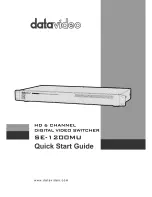
Technical Guide for Limit Switches
•
Do not use the Switch in locations with corrosive gas, such as
sulfuric gas (H
2
S or SO
2
), ammonium gas (NH
3
), nitric gas (HNO
3
),
or chlorine gas (Cl
2
), or high temperature and humidity. Otherwise,
contact failure or corrosion damage may result.
•
If the Switch is used in locations with silicone gas, arc energy may
create silicon dioxide (SiO
2
) on the contacts and a contact failure
may result. If there is silicone oil, silicone sealant, or wire covered
with silicone close to the Switch, attach a contact protective circuit
to suppress the arcing of the Switch or eliminate the source of
silicone gas generation.
Regular Inspection and Replacement
•
If the Switch is normally closed with low switching frequency (e.g.,
once or less than once a day), a reset failure may result due to the
deterioration of the parts of the Switch. Regularly inspect the Switch
and make sure that the Switch is in good working order.
•
In addition to the mechanical durability or electrical durability of the
Switch described previously, the durability of the Switch may
decrease due to the deterioration of each part, especially rubber,
resin, and metal. Regularly inspect the Switch and replace any part
that has deteriorated in order to prevent accidents from occurring.
•
If the Switch is not turned On or OFF for a long time, oxidation of
the contacts may decrease contact reliability. Faulty continuity may
result in accidents.
•
Be sure to mount the Switch securely in a clean location to ensure
ease of inspection and replacement. The Switch with operation
indicator is available, which is ideal if the location is dark or does
not allow easy inspection or replacement.
Storage of Switch
•
When storing the Switch, make sure that the location is free of
corrosive gas, such as H
2
S, SO
2
, NH
3
, HNO
3
, or Cl
2
, or dust and
does not have a high temperature or humidity.
•
Be sure to inspect the Switch before use if it has been stored for
three months or more.
Weather Resistance, Cold Resistance, and Heat
Resistance
Silicon rubber is used to increase resistance to weather, cold, and
heat. Silicon rubber, however, can generate silicon gas. (This can
occur at room temperature, but the amount of silicon gas generated
increases at higher temperatures.) Silicon gas will react as a result of
arc energy and form silicon oxide (SiO
2
). If silicon oxide accumulates
on the contacts, contact interference can occur and can interfere with
the device. Before using a Switch, test it under actual application
conditions (including the environment and operating frequency) to
confirm that no problems will occur in actual.
Outdoor Use
•
If the Limit Switch is used in places with sludge or dust powder
spray, make sure that the mechanical parts are sealed with a
rubber cap.
•
The rubber materials exposed to ozone may deteriorate. Check
that the rubber parts are made of environment-resistive materials,
such as chloroprene, silicone, or fluorine rubber.
•
Due to capillary attraction, rainwater may enter the Limit Switch
through the lead wires or sheath. Be sure to cover the wire
connections in a terminal box so that they are not directly exposed
to rainwater.
•
If the Limit Switch is used outdoors, the steel parts of the Limit
Switch (such as the screws and plunger parts) may corrode.
Models with resistance against climatic conditions have been
added to the series. Consider using outdoor models, such as the
WL-
@
P1 or D4C-
@
P.
•
"Limit Switch is used outdoors" refers to an environment where the
Limit Switch is exposed directly to rainwater or sunlight (e.g.,
multistory parking facilities) excluding locations with corrosive gas
or salty breezes. A Limit Switch used outdoors may not release due
to icing and may not satisfy specified standards.
Operation
•
Carefully determine the position and shape of the dog or cam so
that the actuator will not abruptly snap back, thus causing shock. In
order to operate the Limit Switch at a comparatively high speed,
use a dog or cam that keeps the Limit Switch turned ON for a
sufficient time so that the relay or valve will be sufficiently
energized.
•
The method of operation, the shape of the cam or dog, the
operating frequency, and the travel after operation have a large
influence on the durability and operating accuracy of the Limit
Switch. The cam or dog must be smooth in shape.
•
Appropriate force must be imposed on the actuator by the cam or
dog in both rotary operation and linear operation.
If the dog touches the lever as shown below, the operating position
will not be stable.
Easy to inspect
Difficult to inspect or install
The cover must be located in the
direction ensuring ease of
maintenance or inspection.
Incorrect
Correct
Snapped
back
Abruptly
actuated
Incorrect
Correct
Snapped
back Abruptly
actuated
Incorrect
Dog
Dog
Correct
http://www.ia.omron.com/
C-5
(c)Copyright OMRON Corporation 2007 All Rights Reserved.
































